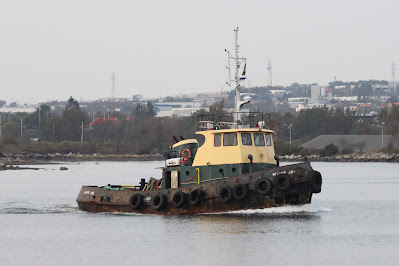A tug / standby vessel, once a regular in Halifax was recently reported with engine trouble in Turkey. Renamed Mirjana K when it was sold in 2021, it was better known in Halifax as the Atlantic Tern.
Atlantic Tern was built in 1975 as the anchor handling tug supply vessel (AHTS) Canmar Supplier II
by Vito Steel Boat and Barge Construction Ltd of Delta, BC. First
owners, Dome Petroleum, through their offshore subsidiary Canmar Drilling,
used the boat in the Beaufort Sea.
![]()
Amoco took over the debt-ridden Dome
and Canmar, and eventually closed down the arctic operations. By that
time the boat had been renamed Supplier II but became Canmar Supplier II again (twice) until finally sold in 1998 to the Norwegian company Remoy. They renamed it REM Supporter until selling it to the Faroe Islands operator Thor p/f in 2005. It then became Thor Supplier. During this time it was extensively modified with the addition of an aft facing bridge structure and raised forecastle.
In 2012 Atlantic Towing Ltd acquired the boat and renamed it Atlantic Birch II *. Initially
it worked as a support vessel for seismic work off Greenland, but by
2013 it was back under Canadian flag and registered as Atlantic Tern. Paired with Atlantic Condor the boats shuttled to and from the Deep Panuke site, about 250 km southeast of Halifax. Atlantic Tern spent more time in the standby role, leaving Condor for the heavier loads.
![]()
When the offshore gas installations were decommissioned the Atlantic Tern was laid up in Stephenville, NL in August 2020. It was sold in early 2021 and renamed Mirjana K under Panama flag and sailed in May 2021 for Rotterdam. The new owners, imaginatively named Project Canada IC Ltd, were rumoured to be Croatian. Recent listings show owners as Boyut Endustriyel of Gebze, Turkey.
It is now reported that the vessel suffered engine failure in Greek waters on March 1, 2023. The Bas Viking took the vessel in tow for the Yalova Shipyard for repairs on April 12. Assistance was provided by the Turkeli for the passage through the narrow Canakkale Strait (aka Dardanelles) for an arrival of April 16.
* The naming tradition for Atlantic Towing Ltd goes back to the early towing operaiotns of the J.D.Irving companies. They had a number of tugs working the Saint John River and tributary lakes, with timber booms and later chip barges. The tugs were named after soft wood (coniferous) trees - the preferred wood for use in making paper. Alder, Cedar, Fir, Juniper. Pine and Spruce, were among the native species that were selected as names.
The Irving interests also had harbour and deep sea tugs that operated in saltwater predominantly, and they were named for hardwood (deciduous) trees. Names such as Birch, Beech, Elm, Hickory, Maple, Oak and Walnut were used for those tugs. One interesting tree selection was the Teak, used for a tug built in Singapore.
When Atlantic Towing Ltd became more formalized as a division of J.D.Irving Ltd, and water transport of wood products came to an end, the naming lines became blurred and both softwood and hardwood tree names were applied to the harbour and seagoing tugs. For example sister tugs Atlantic Fir and Atlantic Oak both work out of Halifax.
Atlantic Towing Ltd also entered the offshore supply business and chose to name its tug/suppliers after sea and shore birds. Most of the species selected were commonly found in the Atlantic Canada region, but there were exceptions, such as the inexplicable Condor. The Atlantic Tern as reported above was initially given the (in my opinion) inappropriate name of Atlantic Birch II. In fact it was the third tug to carry the Birch name, but the second "Atlsantic Birch" . As an offshore vessel it was soon renamed for the family of seabirds - the Tern.
Tugs owned by the Irving interests were named with the prefix "Irving" until the late 1990s when they were renamed with the prefix "Atlantic". The first tug using the Birch name was the Irving Birch, built in 1941 as the Assurance class HMS Charon later HMS Alligator. It served the Irving fleet from 1959 to 1969, by which time it had been replaced by a second Irving Birch built in 1967. That tug became the Atlantic Birch in 1997 and was broken up in 2013.
.































.JPG)





















































